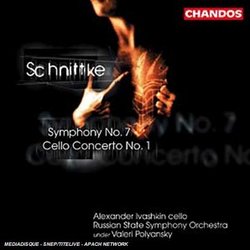| All Artists: Alfred Schnittke, Valery Polyansky, Russian State Symphony Orchestra, Alexander Ivashkin Title: Schnittke: Symphony No.7/Cello Concerto No.1 Members Wishing: 2 Total Copies: 0 Label: Chandos Release Date: 8/22/2000 Genre: Classical Styles: Forms & Genres, Concertos, Historical Periods, Modern, 20th, & 21st Century, Instruments, Strings, Symphonies Number of Discs: 1 SwapaCD Credits: 1 UPC: 095115985229 |
Search - Alfred Schnittke, Valery Polyansky, Russian State Symphony Orchestra :: Schnittke: Symphony No.7/Cello Concerto No.1
 | Alfred Schnittke, Valery Polyansky, Russian State Symphony Orchestra Schnittke: Symphony No.7/Cello Concerto No.1 Genre: Classical
|
Larger Image |
CD DetailsSimilarly Requested CDs
|
CD ReviewsMusica de Profundis Thomas F. Bertonneau | Oswego, NY United States | 11/02/2000 (5 out of 5 stars) "I have blown hot and cold over the late Alfred Schnittke (1934-1998), who might well be, as his enthusiasts claim, the real successor of Shostakovich in Russian, Post-Soviet, music. I owned a half-dozen of the BIS recordings of his music, but gave them away a year or so ago, except for the two cello concertos and the Concerto Grosso/Symphony (No. 4/No. 5). The two solo vehicles, despite their high level of harsh dissonance, are musically entirely convincing. I also remain steadfast by the Eighth Symphony (on Chandos, with Polyansky), where the level of dissonance has dropped down several notches and the instrumental textures have become quite spare. The new Chandos CD brings us the Seventh Symphony (1994), again under Polyansky, and the First Cello Concerto (1986), with Alexander Ivashkin as soloist. The Seventh Symphony, Schnittke's most Shostakovichian, consists of three gnomic movements: An Andante (5.03), a Largo (3.51), and an Allegro (14.31). Although it calls on a standard ensemble, its spare textures make it sound like a chamber symphony. (It has been arranged for chamber forces.) The dynamics of this symphony rarely rise above a discreet mezzo forte. The First Movement opens with violin alone, eventually joined by the rest of the strings and some of the woodwinds. The Second Movement follows attaca. It, too, concerns mostly the strings; long pauses mark the "progress" (say rather the "anti-progress") as the music slowly disintegrates into isolated sounds. The Third Movement calls forth the spirit of Shostakovich and makes use, among the spare sounds, of a banal waltz-tune that assumes ironic importance, as in one of DSCH's late string quartets. This symphony will haunt listeners for a long time, and I predict that they will return to it. What makes the two cello concertos so impressive is their symphonic character; they are indeed more symphonic than at least half of the nine symphonies. In this reading of the First Concerto, Polyansky softens the outlines compared with Leif Segerstam on BIS; cellist Ivashkin cooperates with maestro Polyansky in this approach. Not that the ragged edges of this music could ever be blunted, but the quieter dynamic levels serve to remind us that this music came from the desk of an invalid trying to recuperate from a stroke. By the time the concluding Fourth Movement Passacaglia had played out, Polyansky and Ivashkin had convinced me that Schnittke belongs among the greats of the second half of the 20th century." Masterworks! villegem | canada | 02/14/2003 (5 out of 5 stars) ""...to me both these works seem not only intensely depressing but hysterically over-stated.Michael Oliver (From: Gramophone, September 2000)"Well, Mr Oliver must be quite insensitive to qualify Schnittke first cello concerto "depressing". The 4th movement passacaglia is one of the most poignant, resurrection and ultimately luminous piece of music written. As for the Seventh symphony, the dramaturgy is brilliantly expressed by a minimalist use of the colors of orchestra, intellignetly conducted by Polyansky. This is a must have recording! and Oliver should be ashamed..." A strange, spooky symphony and a splendid concerto R. Hutchinson | a world ruled by fossil fuels and fossil minds | 06/11/2005 (5 out of 5 stars) "Schnittke's Symphony No. 7 may have the strangest form of any work ever to be called a symphony. Only 24 minutes long, it begins with two short movements (andante and largo), and then concludes with a 14'30 allegro. The piece begins with a 42-bar violin solo, and nowhere are the full orchestral forces deployed at once. The music sounds like a fearful walk through a dark woods, with shadows that might be monsters all about -- it's ominous and grotesque but verging on comical at turns as well. Penultimately there is a promising outbreak, a Brucknerian horn chorale, followed by a harsh response from the strings, and then a haunted melody from winds and trumpet. As the momentum subsides, the piece ends with a waltz played on tuba, contrabassoon and double bass.
The second work on this disc is nearly twice as long -- the "Cello Concerto No. 1," (40'), here played by Alexander Ivashkin. This is a tremendous performance, far surpassing the original recording by Natalie Gutman (see my review of the 1986 recording in the Moscow Studio Archives series). Ivashkin's tone is warmer and more lyrical than Gutman's, and Valeri Polyansky leads the Russian State Symphony Orchestra to a splendid performance, much better than that of Gennady Rozhdestvensky in the original. The composition of the "Cello Concerto" was interrupted by Schnittke's first stroke in 1985. He had left three movements, which he had to rework because he had forgotten it all, and that was supposed to be the entire work. But a wonderful fourth movement, a largo, came to him, featuring an absolutely lovely cello line. This is the best performance of one of Schnittke's finest works. So far Polyansky has recorded Schnittke's Symphonies 2, 4, 6, 7 and 8 for Chandos, and they are of uniformly superb quality. I eagerly await Nos. 3, 5 and the as yet unrecorded 9! There are those who disparage Schnittke's symphonies, especially the late ones (see Gramophone's reviews, for instance) but given the quality of Schnittke's "late" 6th, 7th and 8th Symphonies according to MY ears, I hope we don't have long to wait to hear his last, Symphony No. 9. It's a shame that the cover is not appearing on Amazon -- it is a stunning time-lapse photo of a falling, burning book and two hands, against a black background. I'm not ordinarily overly impressed with the Chandos art department, but this is one of their finest. " |

 Track Listings (7) - Disc #1
Track Listings (7) - Disc #1


